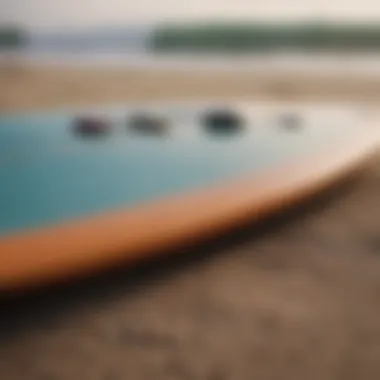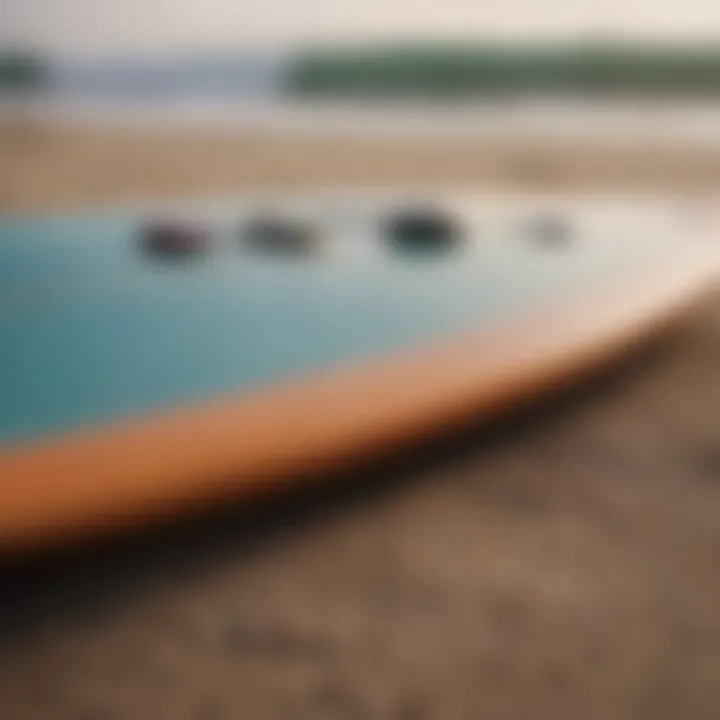A Guide to Buying the Perfect Surfboard


Intro
Buying a surfboard is akin to selecting a trusty steed for your oceanic adventures. From the first wave you ride to the thrilling turns you make, the right board can make all the difference. As you embark on this journey, there are several factors to consider that will not only impact your performance but also enhance your overall surfing experience.
In this comprehensive guide, we’ll navigate through the myriad choices available, explore the different surfboard types, highlight key features, and delve into the often-overlooked aspect of sustainability in surfboard production. Whether you find yourself drawn to the serene waves as a beginner or are tackling gnarly breaks as a seasoned pro, understanding your options is crucial.
Before you set foot in a surf shop, it’s essential to understand the fundamentals of how boards can differ. We aim to equip you with the requisite knowledge, from evaluating a board’s specifications to appreciating the nuances of care and maintenance. So saddle up, because finding your ideal surfboard is about to get a whole lot clearer.
Understanding the Basics of Surfboards
To dip your toes into surfing, it's essential to grasp the fundamentals of surfboards. This aspect forms the backbone of your journey. Understanding the basics of surfboards isn’t merely for the novices; it resonates through every surfer’s experience—whether a beach bum or a seasoned wave rider. The right surfboard not only molds your surfing techniques but also shapes your enjoyment on the water.
The surfboard is more than a piece of equipment; it is a direct line to the surf. Picking the right board can mean the difference between riding waves with ease or flopping about like a fish out of water. Factors such as your skill level, the type of waves you plan on conquering, and even your personal style and preferences all come into play in this choice. If you want to glide smoothly, you’ll need to match your energy with the right board that fits your unique vibe.
Let's take the time to break this down:
- Skill Level: New surfers should focus on stability, while advanced surfers might prioritize maneuverability.
- Wave Types: Shortboards shine in steep, fast conditions, whereas longboards are better for gentle, rolling waves.
- Personal Preference: The feel of a board underfoot can be subjective, hence trying different shapes can be pivotal.
"Understanding the basics serves as the first stepping stone to not only making an informed choice but also enhancing your overall surfing experience."
Exploring fundamental surfboard characteristics lays the groundwork for grasping what makes each one unique. By diving deeper into what a surfboard is and why your choice matters, you can tailor your surfing adventure with precision.
Types of Surfboards
When it comes to the art of surfing, not all surfboards are created equal. The type of surfboard you choose can make a world of difference in your experience on the waves. Understanding the distinct categories helps you find a board that suits your skill level, style, and the conditions you'll be facing. Here, we’ll unpack various surfboard types, looking at their benefits and unique characteristics, ensuring you are well-equipped to make an informed decision.
Shortboards
Shortboards are the go-to for many serious surfers. Typically measuring between 5 to 7 feet, they are designed for agility and speed. Their narrow profile and sharp tail shape allows for quick turns and radical maneuvers, ideal for catching powerful waves.
However, riding shortboards isn’t for everyone. If you’re still finding your balance or you ride smaller, softer waves, this might not be the best choice initially. They do require a solid level of skill and a knack for positioning yourself swiftly in the water. That said, if you are looking to carve more challenging waves, investing in a shortboard can be a game-changer.
"A shortboard feels like an extension of your body, once you get the hang of it, there's nothing like it."
Longboards
On the flip side, longboards are usually 9 feet or more and provide a very different surfing experience compared to shortboards. They are perfect for cruiser-style riding and prioritize stability over aggressive maneuvers. For beginners, a longboard is often recommended due to its forgiving nature.
The wide, flat design makes it easier to paddle and catch waves, giving you more time to focus on standing up and finding your rhythm. In lighter surf conditions, longboards shine, as they can glide smoothly, embracing each swell like it’s a Sunday stroll at the beach.
Fish and Fun Shapes
"Fish" boards are fun, often recognized for their distinct wider tails and shorter length, usually between 5 to 6.5 feet. These boards are designed primarily for maneuverability in smaller, choppy waves. They allow you to whip around with the utmost ease and are great for surfers looking to break their normal style.
Then, there are fun shapes—boards that set creativity free, oftentimes blending elements from both short and longboards. Think retro designs, rounder noses, and varied tail shapes. These boards cater to someone who wants to explore, providing a distinctive ride that offers versatility.
Fish and fun shapes can be an exciting choice for those looking to try something new but still want a stable platform to learn on.
Foam Boards
For newcomers to the surfing world, foam boards present a friendly introduction to the sport. Made from lightweight foam, they are soft on impact—ideal for learning without the fear of bruising or injury. These boards are typically thicker, which contributes to their buoyancy and stability.
While they might not perform like fibreglass boards, foam boards help build confidence in paddling and standing up. They also work wonders in smaller wave conditions, letting you enjoy the ocean without the pressure of advanced techniques.
In summary, the right board not only enhances your skills and adaptability but can also greatly affect your enjoyment of surfing. As you step into the waters, understanding the nuances of each board type provides you with a solid foundation, empowering you to ride with confidence.
Key Features to Consider
When it comes to purchasing a surfboard, pinpointing the right features is crucial. The surfboard you choose isn't just a piece of foam and fiberglass; it’s an extension of your surfing capability. Selecting the right features can enhance your experience in the water and even help you progress your skills faster. Let’s break down some essential components you should consider.
Volume and Displacement
Volume refers to the overall capacity of the surfboard and plays a significant role in how it floats. For surfers just starting out, high-volume boards can be more forgiving, allowing for better balance and easier paddling. This can make all the difference between catching your first wave and spending your session just trying to stay afloat. Similarly, displacement is a term often used to describe how a board moves through water; it determines how smoothly the board rides and the speed it can attain.
A simple way to think about volume and displacement is like this: a boat. A larger boat will float better in rough waters, while a smaller one could get tossed around. For surfing, the right volume can provide stability or agility, depending on what you're looking for.
"When choosing a surfboard, it's not just about catching waves; it's about how well the board responds to your actions in the water."
Material Composition
The material your surfboard is made of can have a significant impact on its weight, durability, and overall performance. The most common materials for surfboards include polyurethane (PU), polystyrene (EPS), and epoxy. PU boards tend to be heavier and potentially more fragile while offering a traditional feel. In contrast, EPS boards are often lighter and more buoyant, appealing to surfers who might want speed and leniency underfoot.


Epoxy boards, while sometimes pricier, are renowned for being exceptionally durable and less susceptible to dings, making them ideal for those who take a beating from Mother Nature. They may stand up better to waves over time, limiting how often you might need repairs. When you’re thinking about material composition, consider your surfing environment and how often you’ll be in the water.
Tail Shapes and Their Impact
The tail shape of a surfboard significantly influences how the board reacts in various conditions. From a squash tail offering a bit of stability to a pintail which provides more control, each shape has its pros and cons. A wide tail, for example, can create quick acceleration, particularly useful in mellow conditions. Conversely, a narrower tail allows for sharper turns, an advantage in powerful surf.
Furthermore, unique tail designs, like the swallow tail, can assist in maneuverability and keep speed during sharp turns. Understanding these shapes can aid you in selecting a board that aligns with both your skill level and surfing style. Always remember: a well-matched tail shape can help you ride the waves with finesse.
Fin Configurations
Fin setups are like the steering wheel of your surfboard, directly affecting how well it handles in the water. Surfboards generally feature either single fin, thruster (three fins), or quad fin setups. A single fin setup provides a classic feel, great for long, smooth rides, while a thruster setup adds significant versatility, allowing for more aggressive turns and increased grip on the wave face.
Quad fins offer lightning-fast speeds and enhanced maneuverability, particularly useful in powerful waves. It’s also worth noting that fin materials can differ (plastic or fiberglass), affecting performance too. Choose wisely, as the fin configuration you opt for can either elevate your surfing experience or make it downright frustrating.
When it comes down to it, understanding these key features—volume and displacement, material composition, tail shapes, and fin configurations—can put you a step ahead of the game. The right surfboard isn’t just about aesthetics; it’s about compatibility with your particular surfing style and conditions. Take time to factor these into your decision to ensure a board that works for you, rather than against you.
Determining Your Skill Level
Understanding your skill level is vital when diving into the world of surfboards. Each level of surfer has unique needs that can dramatically impact the enjoyment and safety of the surfing experience. Commencing with the correct board according to one's skills ensures not only better performance but also promotes a more rewarding time on the waves. The right board fills the gap between a frustrating ride and one that brings joy and accomplishment.
Beginner Surfboards
For those just starting in the water, choosing a beginner surfboard is key to fostering a healthy relationship with surfing. Typically, these boards are wider and longer, offering enhanced stability. A foam board or a soft-top surfboard often meets the needs of novices.
The larger surface area helps with balance, allowing beginners to practice paddling and standing with greater ease. Here are a few points to consider:
- Stability: Boards like the Wavestorm or a Soft Top Surfboard give extra buoyancy.
- Forgiveness: They can absorb some minor hiccups, providing newcomers with space to learn.
- Durability: Foam boards tend to withstand bumps and drops, perfect for new surfers still getting their feet wet.
Opting for a slightly larger board, like a longboard, can also be beneficial. It will provide ample surface for balance and is generally easier to catch waves.
Intermediate Options
Once a surfer is comfortable standing and catching some basic waves, they'll want to step up their game. Intermediate surfers typically look for boards that offer a bit more performance. This often means transitioning to shorter boards yet still holding on to some stability. The most suitable options may include fish boards or hybrid designs.
When selecting an intermediate board, consider the following:
- Shape and Size: Fish boards bring a unique shape that adds maneuverability while still aiding in paddling.
- Performance: Shortboards can build speed and help with sharper turns but may require more skill to handle effectively.
- Flexibility: Depending on your preferred wave size, a board with the right configuration can make all the difference.
A model like the Channel Islands Fish might suit those stepping up to more challenging waves, catering to those evolving skills.
Advanced Choices
Advanced surfers usually have specific preferences tied largely to technique and style. Surfboards at this level are often shorter, allowing for enhanced performance and maneuverability. These boards could be something like a high-performance shortboard.
As you refine your surf skills, the following aspects become paramount:
- Precision and Control: Advanced boards may have sharper tails or a sophisticated rockers that facilitates tighter turns.
- Customization: Riders often look for boards designed and shaped by reputable shapers tailored to their unique style.
- Material Quality: High-performance boards often utilize epoxy or advanced fiberglass for strength and lightness, improving speed.
For example, boards like the lost Puddle Jumper can elevate an expert's artistry on the waves, pushing limits and exploring new maneuvers.
Choosing the right surfboard hinges not just on technical skills but also on personal surfing goals. By thoughtfully assessing one's level and matching it with the right equipment, surfers can pave the way for mesmerizing adventures on the water.
Choosing the Right Surfboard for Your Style
Selecting a surfboard is not just about picking one that looks cool or has a fancy label attached to it. It goes far deeper than that. The right surfboard can enhance your experience, aligning with your personal style and the conditions you'll be riding in. A tailored choice contributes not only to improved performance but also ensures greater enjoyment on the water. Let’s explore how to match your board with your surfing character.
Performance vs. Stability
When you're out on the waves, two terms often pop up—performance and stability. Finding the right balance between these elements is essential. Performance-oriented boards are typically designed to respond sharply to the rider’s movements, enabling sharp turns and quick maneuvers. This is great for experienced surfers who thrive on adrenaline and quicker waves.
On the flip side, stability is a strong suit of many longboards and even some wider shortboards. These boards offer a more forgiving ride, giving you confidence in choppier water or when you’re just getting a feel for balancing on a surfboard. If you’re the type to enjoy long, steady rides and less aggressive maneuvering, then stability should be high on your list of must-have features.
Consider this: if you’re charging at faster waves, you may want a board that lets you carve sharply without losing control. Conversely, on mellow days at the beach, a stable board allows you to paddle out without worry, soak up the sun, and enjoy the feeling of the water without being tossed about.
"Choosing the right surfboard is like picking the right dance partner—if you don’t sync up, you’re going to stumble!"
Wave Conditions
The type of waves you plan to ride plays a crucial role in determining the right surfboard for your style. Not all boards are created equal when it comes to handling different types of waves. Understanding the wave you’ll be surfing on can guide your decision significantly.
For instance, let’s get specific: when cruising on powerful, steep waves, a shorter and more agile board often stands out. These performance boards cut through the water efficiently and react quickly, which is necessary for deep drops and sharp turns. Think about rides in places like Jeffrey's Bay, where you want every ounce of speed to navigate those exhilarating barrels.


On a different note, when the weather's just a tad too mellow, and the waves are soft and rolling, longboards become your best friends. The elegance of the ride combined with the stability can turn a simple day at the beach into a smooth, enjoyable glide.
In addition, you also have to factor in the tide and wind conditions. For varies tidal patterns, you might choose boards that excel in those specific sets of circumstances. If it’s a windy day, a heavier board could be favorable, allowing you to focus on your ride without worrying too much about being blown off course.
At the end of the day, being attuned to the kind of waves you are surfing not only helps in selecting the perfect board—it ensures that each session meets your preference and capabilities, forming the basis for growth in your surfing journey.
Sourcing Your Surfboard
When it comes to buying a surfboard, sourcing can make or break your experience. It’s not merely about selecting a board that looks appealing or has the latest trendy graphics; it’s about finding the right place to purchase it from. This part of the journey holds significant weight in ensuring that you not only choose a board that suits your style and ability but also engage with a seller knowledgeable about the intricate details of surfboards.
By identifying reliable sources, you can access valuable insights, recommendations, and variations that may not be apparent at first glance. Understanding the key differences between various outlets can ultimately enhance your surfing experience, providing you with a product that fits your needs perfectly.
Local Shops vs. Online Retailers
Going into a local surf shop can be a game-changer. You get the tactile experience of handling the boards, which can tell you a lot about their weight and feel. Shops often employ seasoned surfers as staff, individuals who know their stuff. You can ask questions and possibly even receive tailored advice that aligns with your level and surfing aspirations. Local shops also often have a closer connection to the surfing community; buying there can feel like you’re supporting your local surf culture.
However, the convenience of online retailers can't be overlooked. They offer extensive medley of boards, often at more competitive prices. Platforms such as Craigslist or eBay might even net you a second-hand bargain. The drawback? Lack of direct interaction can mean missing out on expert guidance.
Here's a quick look at the pros and cons:
- Local Shops:
- Online Retailers:
- Pros: Hands-on experience, expert advice, community support.
- Cons: Limited inventory, potentially higher prices.
- Pros: Wider selection, competitive pricing, convenience.
- Cons: No tactile experience, limited personal interaction.
The choice between local shops and online retailers often comes down to personal preference, balancing the value of community connection against the convenience of online shopping options.
Purchasing from Shapers and Artisans
Buying directly from shapers and artisans adds a new dimension to the purchasing process. These are the individuals who conceptualize and construct surfboards from scratch. By purchasing from them, you often get a board that is custom made to fit your unique style and needs. This could range from the size and shape to the graphics that resonate with you personally. This personalized touch can enhance your connection with the board, reflecting your individuality in every ride.
Artisans typically take pride in their craft, often using sustainable or innovative materials that can have a positive impact on your local environment. Supporting these creators not only enriches your surfing journey but also contributes to the tradition and craft of surfboard making.
Here are some aspects to consider when purchasing from shapers:
- Craftsmanship: Generally, boards made by hand often display superior attention to detail.
- Customization: You may have the option to discuss parameters, allowing you to create a board that fits your style and preferences.
- Storytelling: Every board from a shaper has a story. Listening to it can deepen your appreciation and enjoyment of your surfing experience.
Ultimately, sourcing your surfboard wisely can significantly sway your overall enjoyment and proficiency in surfing. Whether you lean towards local shops, online retailers, or artisans, being informed will help ensure you're investing in a board that complements your surfing journey.
Assessing Prices and Budgeting
When it comes to diving into the world of surfboards, understanding your budget and the prices associated with different types of boards is crucial. Not only does this knowledge help avoid overspending, it also allows you to make more informed choices about your surf gear. For those new to the surfing game, the world of surfboards can be as vast as the ocean itself, filled with options that cater to various skill levels and surfing styles.
In essence, assessing prices and budgeting is about value for money. A surfboard should not just be seen as a one-time purchase, but an investment that will serve you well in your adventures. When making decisions, consider the long-term aspects: how often you surf, the conditions you usually explore, and what kind of progression you aim for in your skill development.
Understanding Price Ranges
Navigating through price ranges might feel like wading through deep waters, especially if you’re just starting out. Surfboards can range anywhere from a few hundred dollars to several thousand, depending on various factors. Here’s a brief overview of what you might expect:
- Entry-level Boards: For beginners, prices often sit in the $200 to $500 range. These boards are generally made from durable materials, making them suitable for those learning the ropes.
- Mid-range Boards: Expect to pay between $500 and $1,000 for intermediate boards. These typically offer a better performance structure, catering to those who are gaining confidence on the waves.
- High-end Boards: For seasoned surfers who demand top-notch quality and performance, prices often soar to $1,000 to $2,000 or even more. These boards are crafted with precision and designed for specific wave conditions and maneuvers.
Ultimately, understanding these price ranges aids in setting realistic expectations as you shop.
Value vs. Cost
When grappling with the expenses of purchasing a surfboard, it's useful to differentiate between value and cost. While cost is the dollar amount spent, value is about what you get in return.
It's common to see a surfboard that’s cheaper on the surface yet fails to deliver performance or durability, leading to additional expenses on repairs or replacements down the line. In contrast, a slightly more expensive board that meets your needs can prove much more economical in the long run.
Here are a few points to ponder:
- Durability: A board made with high-quality materials may cost more but can withstand the rigors of surfing, especially in harsh conditions.
- Performance: Investing in a board tailored to your skill set and surfing style can elevate your experience and skills faster than settling for a low-cost option that hinders your growth.
- Resale Value: Some surfboards retain their value better than others. High-quality brands often have a strong resale market, giving you some cushion if you decide to upgrade later.
"Understanding the difference between cost and value is key to making savvy surfing decisions. A board may seem pricey, but the right one could enhance your experience for years to come."
Sustainability in Surfboard Production
In today's surf culture, sustainability is no longer a buzzword but a critical aspect of buying a surfboard. The surfing community is becoming increasingly aware of the impact that their choices have on the environment, leading to a growing demand for eco-friendly options. This section delves into sustainable practices in surfboard production, examining the materials used and the manufacturing methods that prioritize the health of our oceans and planet.
Eco-friendly Materials


One aspect of sustainability that surfers should consider is the materials used in the construction of surfboards. For a long time, traditional surfboards have been made from materials that are not easy on the environment. Polyurethane foam and polyester resin, while common, can release harmful chemicals during production and disposal. Enter eco-friendly materials.
- Bio-based Resins: These resins are derived from renewable sources, like plants. They significantly reduce reliance on petroleum-based products.
- Recycled Foam: Some manufacturers have begun using recycled materials to create the foam cores of boards, reducing waste and conserving resources.
- Bamboo and Wood: Wood surfboards are gaining traction due to their minimalist aesthetic and lower environmental impact. Bamboo is particularly popular for its fast growth cycle and strength.
When considering eco-friendly options, it’s essential to choose brands that emphasize transparency about their materials. Check if the company provides information on where their raw materials come from and whether they have certifications to back up their claims.
Responsible Manufacturing Practices
Beyond materials, the manufacturing practices used by surfboard producers play a vital role in sustainability. Many surfboard manufacturers are taking steps to minimize their ecological footprint through responsible practices.
- Locally Sourced Production: Opting for local artisans reduces transportation emissions and supports the local economy. Those small shops tend to have a more personal touch; plus, you get to see the craftsmanship up close.
- Waste Reduction Programs: Some companies are implementing waste management strategies, like recycling scraps created during the shaping process. This approach not only minimizes landfill contributions but also sets a precedent in the industry.
- Sustainable Energy Use: Manufacturers who utilize renewable energy sources, such as solar or wind power, help to decrease their carbon footprint.
"Choosing a surfboard shouldn’t just be about performance; it’s about the legacy we leave behind on our beaches and in our oceans."
Surfboard Maintenance and Care
Understanding how to maintain and care for a surfboard can make a world of difference. Many surfers might view their board as just another piece of equipment, but spending some time on maintenance can not only prolong its life but also enhance your overall surfing experience. It’s akin to how a gardener nurtures his plants, tending to them regularly to yield the best fruits. Just like with any sport, your gear deserves the same attention.
Routine Cleaning and Inspection
Keeping a surfboard clean is more than just about aesthetics; it addresses functionality and safety as well. Saltwater, sand, and sun exposure can degrade the materials of your surfboard over time, leading to problems. A few minutes after every surf session can go a long way.
- Rinse After Each Use: As soon as you come out of the water, rinse your board with fresh water. This simple step helps remove salts and sand that can wear out your board.
- Drying: After rinsing, dry the board with a soft cloth. It’s important to avoid direct sunlight for drying, as UV rays can damage your board.
- Inspect for Damage: While cleaning, take the time to examine your board for cracks or dings. Small imperfections might seem trivial but can expand if left unattended. Regular checks mean catching issues early on.
- Storage Matters: Protect your surfboard when not in use. Store it in a cool, shaded place away from direct elements, and using a board bag can help prevent scratches and dings.
"A little bit of maintenance goes a long way. Treat your board like a friend, and it’ll take you places."
Repairing Minor Damage
Whether you're a seasoned pro or just getting your toes wet, chances are you’ll face minor damage at some point. The ocean has a way of reminding us of its power. Here’s how to deal with those little hiccups:
- Dings and Scratches: If you spot a ding, clean the area and protect it from water until you can properly repair it. Most surf shops sell repair kits that come with resin and instructions.
- Cracks: For hairline cracks, ensure the area is clean and dry. A thin application of repair resin can often seal the damage. Let it cure completely.
- Leashes and Fins: Regularly check your leash and fins. If a fin feels loose or a leash is fraying, replace them. It’s better to be safe than sorry when out in the water.
Taking the time to maintain your surfboard not only preserves its lifespan but also ensures safety during rides, making it a worthwhile investment for any surfer.
Final Considerations Before Purchase
When it comes to buying a surfboard, there are pivotal elements that can finalize your decision, ensuring that your new board suits not just your surfing style, but also personal preferences. Considerations before making a purchase can often make or break your surfing experience. This section not just addresses what to check ahead of wrapping up a purchase, but also emphasizes making a choice that reflects your unique needs and riding aspirations.
Testing Surfboards
Before committing to a surfboard, it’s critical to test the waters, so to speak — quite literally. Taking a surfboard for a spin provides valuable insights into how it feels underfoot. This experience can help avoid the costly mistake of buying a board that doesn’t harmonize with your riding style or comfort.
You might want to explore the following options when testing:
- Local Rentals: Many surf shops offer rentals, providing you a chance to test various shapes, sizes, and types without the full investment.
- Demos: Some shops host demo days where you can try multiple boards. It’s a golden opportunity to feel what suits you best in real wave conditions.
- Borrow from Friends: If you have pals with boards, don’t hesitate to borrow one for a surf session. Sometimes, riding something different could illustrate preferences you never knew you had.
Don’t forget to pay attention to aspects such as stability, buoyancy, and maneuverability when you’re out on the water. Trust your instincts; if something feels off, it’s worth exploring other options.
Seeking Expert Advice
Another essential step in making a well-informed purchase involves tapping into the wealth of knowledge that experienced surfers and instructors can offer. They’ve traversed the waves, wrestled with equipment, and can guide you toward options that fit your skill level and preferences. Here are some practical tips for seeking expert advice:
- Engage with Local Surf Schools: Instructors are invaluable resources. They understand local surf conditions well and can suggest board types that work best for your geographical area.
- Forums and Online Communities: Websites like Reddit can connect you with seasoned surfers. Their shared experiences might reveal considerations you hadn’t contemplated.
- Surf Shops: Establishing a good rapport with local surf shop staff can lead to expert recommendations tailored to your surfing style. Indigenous knowledge about particular boards may shine a light on lesser-known brands or styles that fit well with your needs.
"Talk to people who ride, and you'll find a treasure trove of information. It's not just about the board; it's also about your experience and personal growth as a surfer."
By taking these final steps into account, you not only ensure you’re making a well-rounded decision, but you also set the stage for a fuller, more enriching experience once you hit the waves with your new board.
Building a Community Around Surfboarding
Surfing isn't just a solitary act of gliding over waves; it's a culture, a lifestyle, and above all, a community. When venturing into the world of surfing, establishing connections with others who share your passion can greatly enhance your experience. Building a community offers numerous advantages that can improve not only your skills but also the joy you find in the sport.
Connecting with Other Surfers
Engaging with fellow surfers can provide a wealth of knowledge and support. There are countless ways to foster these connections:
- Local Surf Shops: These places often serve as community hubs where surfers gather. Chatting with shop staff or locals can lead to friendships and surfing partnerships.
- Social Media Platforms: Websites like Facebook and groups on Reddit dedicated to surfing can be great too. They offer forums where surfers share their experiences, tips, and favorite spots. A quick search can connect you to regional surfing communities that align with your skill level.
- Surf Clubs or Collectives: Many regions have formal or informal clubs. Joining one can provide access to group outings, surf sessions, and workshops that hone your skills, all while surrounded by like-minded enthusiasts.
Building these connections doesn’t just improve your comfort in the water; it creates networks of support that encourage continual learning, motivation, and sharing stoke unapologetically. Plus, who doesn't enjoy swapping stories after a long day of paddling?
Participating in Local Events
Attending local surf events is invaluable for personal growth and community building. Events range from competitions to beach clean-up days and surf film nights. Here are reasons to get involved:
- Skill Development: Whether it’s surf contests or workshops, participating helps refine your technique. Encouraging and friendly competition often brings out your best, pushing you to exceed your limits.
- Networking Opportunities: These gatherings connect you with a diverse crowd, from established surfers to newcomers. Figures like instructors and shop owners come to these events, creating chances for mentorship and guidance.
- Creating Shared Memories: There’s a certain magic in shared experiences. Celebrating victories together, supporting each other in losses, and collaborating on community projects forge tighter bonds that can last years.
Involving yourself in local events integrates you into the surf culture, making it easier to find your place. Everyone knows that the ocean can be unpredictable, but the warmth of community is a constant solace. So, get yourself out there, find your tribe, and let the waves carry you to new friendships and priceless moments.















